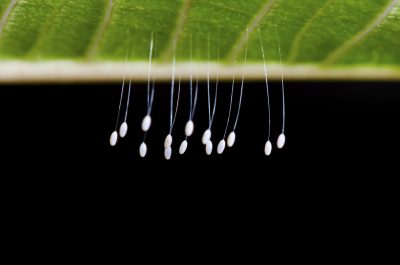






Broad spectrum pesticides can have detrimental effects on the population of “good” or beneficial bugs. Lacewings are a perfect example. Lacewing larvae in gardens are a natural knock out for undesirable insects. They are voracious eaters of many soft-bodied insects that attack plants. For non-toxic pest control, create a lacewing larvae habitat that is attractive and keeps these helpful bugs near your favorite plants.
Lacewings mature in approximately 4 weeks. That takes them from egg to larvae, into the pupal stage and finally emergence as adults. Lacewing insect eggs hatch in 4 to 5 days, releasing tiny alligator-like larvae.
The larvae have large, fierce jaws, brownish coloring with red stripes and spots and rough skin. They are often called aphid lions because they feed on aphids as well as leafhoppers, mites, mealybugs, thrips and many other soft bodied insects. The release of so many hungry jaws can wreak havoc on an aphid or other insect invasion fairly quickly.
Lacewing larvae in gardens eat their way through your problem pests while also undergoing three instars in just a few weeks.
Adult lacewings are fairly easy to identify. Their signature lacy green wings and bottle green color are quite recognizable. However, the larvae and the eggs can be mistaken for other species of insect. What do lacewing eggs look like? The tiny eggs can be difficult to spot, but their unique fixation and the fact that females can lay up to 200 eggs at a time can help you spot these future garden warriors.
Before you go scraping off a cluster of insect eggs on the leaves of your plants, be aware they may be the future beneficial garden cleaners, lacewing larvae. Recognizing the eggs and preserving them will ensure that you can harness their insatiable appetites for your garden.
The typical lacewing larvae habitat is in aphid infested crops such as:
Lacewing insect eggs will be attached by fine filaments to the surface of leaves. These filaments are so delicate and hard to discern that the tiny black eggs seem to be floating on the plant. Leave these insect eggs alone to develop into fierce, ravenous forces for good in the landscape.
Lacewing larvae can actually be purchased but you can also coax adults to make your garden their home. After all, each larvae can eat its body weight of aphids or other pests every day. The best locations for lacewings are areas with a large variety of plants. Adults seek nectar and pollen, which makes blooming plants especially attractive. Sugar sources in the landscape will also attract the adults, as will the honeydew produced by the pesky insects.
If you are purchasing lacewing eggs, release them when temperatures are at least 70 degrees Fahrenheit (21 C.). The recommended distribution is one larvae for every 50 prey in slow growing crops or one larvae for each 10 insect pests in fast growing crops. In orchards and row situations that means a consistent release every 7 to 14 days of larvae. In such areas, up to 30,000 eggs may be required.
In personal garden settings, a fraction of that number should be sufficient and your pest problem controlled safely, naturally and without toxins.
Copyright © www.100flowers.win Botanic Garden All Rights Reserved